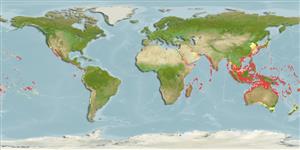Common names from other countries
Classification / Names / Names
Nomi Comuni | Sinonimi | Catalog of Fishes (gen., sp.) | ITIS | CoL | WoRMS
Environment: milieu / climate zone / depth range / distribution range
Ecologia
; distribuzione batimetrica 2 - 71 m (Ref. 101222). Tropical
Indo-Pacific.
Length at first maturity / Size / Peso / Age
Maturity: Lm ? range ? - ? cm Max length : 50.0 cm TL maschio/sesso non determinato; (Ref. 822); common length : 12.0 cm BASL maschio/sesso non determinato; (Ref. 349); Peso massimo pubblicato: 500.00 g (Ref. 2594)
Common among seaweeds and grass flats in shallow water environments, especially in sheltered bays and lagoons (Ref. 349). Found during the day under rocks and at night crawling around reef flats and seagrass beds (Ref. 844). Inhabits eel grass beds, reef flats, or tidal swimming pools (Ref. 866). Nocturnal (Ref. 822).
Life cycle and mating behavior
Maturità | Riproduzione | Deposizione | Uova | Fecundity | Larve
Members of the order Anaspidea are mostly simultaneous hermaphrodites.
Poutiers, J.M. 1998. (Ref. 349)
IUCN Red List Status (Ref. 130435)
CITES status (Ref. 108899)
Not Evaluated
Not Evaluated
Threat to humans
Harmless
Human uses
| FishSource |
Strumenti
Fonti Internet
Estimates based on models
Preferred temperature
(Ref.
115969): 22.6 - 29.1, mean 28 (based on 1616 cells).
Resilienza
Alto, tempo minimo di raddoppiamento della popolazione meno di 15 mesi (K=0.8-1).
Vulnerability
Moderate vulnerability (40 of 100).
Price category
Unknown.
